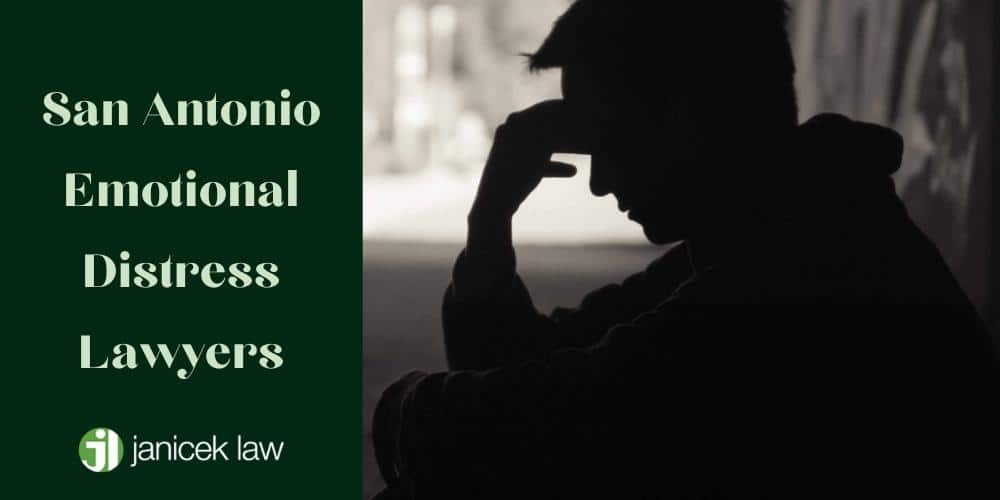San Antonio Emotional Distress Lawyer
San Antonio Emotional Distress Lawyer
After a traumatic experience, it’s common to have lasting injuries and effects. But what many people don’t expect is the lasting emotional pain and mental distress. This invisible injury doesn’t have a neat recovery timeline. Emotional distress can impact every aspect of your life and often lasts much longer than a physical injury.
Working with a qualified emotional distress lawyer can help you recover the compensation you deserve. The personal injury attorneys at Janicek Law have the resources necessary to fight for you. Schedule a free consultation today by calling 210-366-4949.

What is Emotional Distress?
Emotional distress is commonly known as pain and suffering. It encompasses all the negative emotions and feelings after a traumatic experience caused by another person. Emotional distress is more than just feelings of sadness. Physical injuries can leave you stuck on the sidelines, but the invisible injury of emotional distress can leave you feeling alone and feeling depressed. Emotional distress can cause long-lasting medical issues like PTSD, anxiety, and behavioral changes. If you or a loved one is suffering after a traumatic experience, you have legal options available.
Emotional Distress vs. Mental Anguish
Emotional distress and mental anguish are both interchangeable terms for the same thing under Texas law. Both terms refer to greater-than-usual feelings of anxiety, stress, grief, and more.
Signs of Mental Anguish
Emotional distress may be an invisible injury, but it can cause physical symptoms. The most common symptoms include:
- Increased anxiety
- Depression
- Insomnia/difficulty sleeping
- Increased irritability
- Feelings of humiliation
- Chronic headaches
- Uncontrollable crying
- Weight gain or loss
- Panic attacks
- High blood pressure
- Eating disorders
- Gastrointestinal issues and/or poor gut health
Emotional trauma may not directly cause physical pain, but severe emotional distress can lead to long-lasting issues like post-traumatic stress disorder.

Common Causes of Emotional Distress
Under Texas law, emotional distress falls into three different categories. The two main categories are negligent infliction and intentional infliction. The difference is in the nature of the traumatic event. If someone sets out to intentionally cause damage, this can be enough for a claim, even if they don’t succeed in their goal. Negligent infliction is the most common type of emotional distress. We’ve explained each cause of emotional distress in detail below.
Negligent Infliction of Emotional Distress
The most common cause of emotional distress is someone else’s negligence. A car accident, for example, can cause devastating physical injuries and severe emotional distress. You may experience stress and anxiety anytime you get into a vehicle, which prevents you from driving. The at-fault driver likely didn’t intend to cause an accident, but their actions still caused the accident. Auto accidents can cause catastrophic physical injuries like brain injuries, burns, and traumatic amputations. These accidents, in addition to these injuries, can cause severe emotional distress.
Bystander Effect
Maybe you weren’t physically injured in a car accident, but what you witnessed caused irreparable mental damage. This is when the bystander effect comes into play. If you witness one of your family members die in a tragic hit-and-run accident, for example, you can recover compensation for your emotional distress from the negligent driver. If you witnessed a friend or stranger in an accident, you won’t have a case. Bystander cases can only be pursued by family members.
Intentional Infliction of Emotional Distress
The intentional infliction of emotional distress (IIED) is different from accidental or negligent infliction. These cases involve an intentional act of extreme conduct. Name-calling may hurt your feelings, but it won’t get you far in civil court. Intense cyberbullying, on the other hand, can cause feelings of extreme stress and anxiety. If these extreme emotions interfere with your daily life, you can fight for compensation. Sexual abuse, child abduction, and nursing home abuse are other examples of IIED.

Can I Sue for Emotional Distress?
The strongest emotional distress cases include a physical injury. Hurt feelings alone often aren’t enough to claim compensation. Texas law allows people to sue for emotional distress related to a physical injury or sexual abuse. In some cases, physical injury is not required for an emotional distress case. The victim’s emotional distress must be enough to prevent them from performing functions of their daily life or decrease the victim’s quality of life. If you were involved in an accident that caused emotional distress, you have legal rights available.
Mental Anguish Damages
Personal injury claims have three types of compensation you can recover: economic, non-economic, and punitive. Economic damages include costs like medical treatment, lost wages, and property damage. Economic damages allow you to recover compensation for tangible costs.
Non-economic damages, on the other hand, let you recover compensation for not-so-tangible losses. This category includes pain and suffering, loss of consortium, and other losses associated with your emotional health.
Punitive damages are intended to punish the responsible party for gross negligence or disregard for human life. The court may award the victim punitive damages if the responsible party made deliberate poor choices, like drinking and driving.
Texas Statute of Limitations
Recovering from any type of accident takes time. Unfortunately, time is often not on your side. Under Texas law, injured victims have only two years to file a compensation claim for emotional distress. Two years may seem like more than enough time, but it will pass by before you know it. It’s critical to get started on your case as soon as possible after the accident. Starting sooner rather than later can mean that you get the chance to collect all the evidence needed for your emotional distress claim. The San Antonio emotional distress attorneys at Janicek Law can focus on fighting while you focus on recovering.
What Do I Need to File an Emotional Distress Claim?
Proving emotional distress can be a complicated procedure. As with any personal injury claim, you and your legal team must be ready to prove your case to a judge and jury. In order to prove emotional distress, your legal team may use:
- Medical records
- Mental evaluations
- Accident reports
- Expert testimony
- Journal with daily symptoms
Emotional distress evidence isn’t as simple as presenting a doctor’s note. Emotional distress claims must go above and beyond to prove the true extent of the damage. Working with an experienced emotional distress attorney from Janicek Law can be essential to your case.

How the San Antonio Emotional Distress Attorneys at Janicek Law Can Help
Traumatic incidents can take a toll on your physical health and your mental well-being. With the major focus on mental health in recent years, people have begun to understand the importance of taking care of emotional health after a traumatic experience. If you or a loved one is suffering from emotional distress, the personal injury attorneys at Janicek Law are ready to help. Our experienced team has served the San Antonio area for more than 25 years. For more information about how we can help, schedule a free consultation today by calling 210-366-4949.
